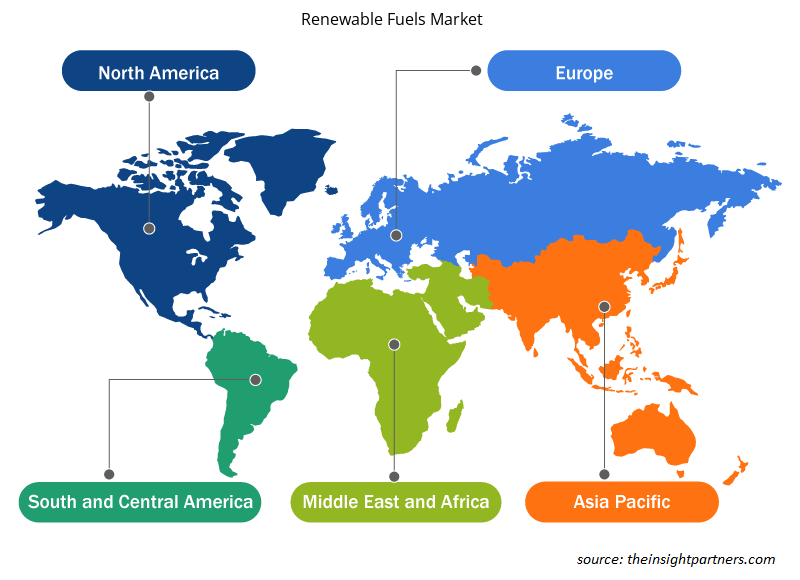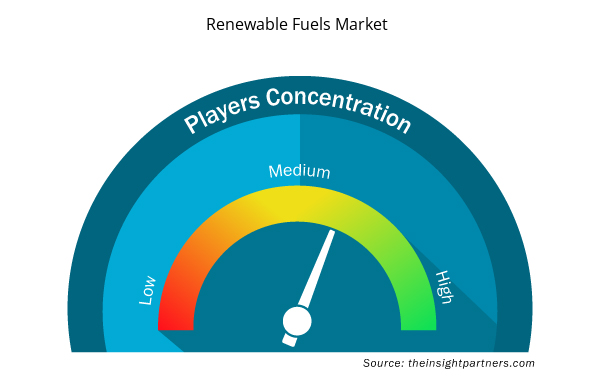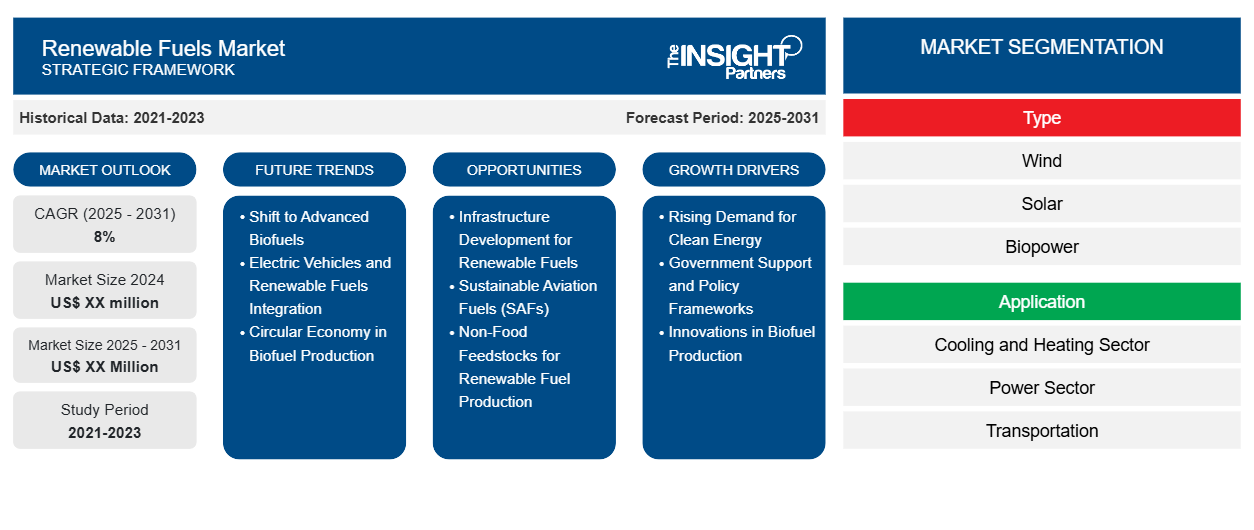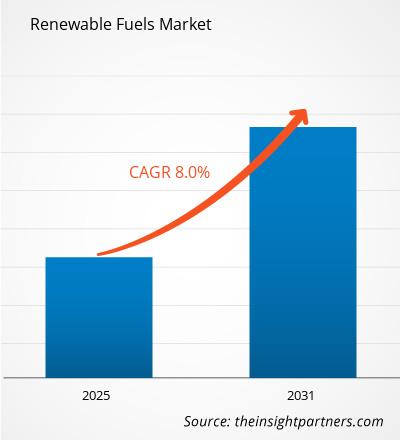再生可能燃料市場は、2023年から2031年にかけて8%のCAGRを記録し、市場規模は2023年のXX百万米ドルから2031年にはXX百万米ドルに拡大すると予想されています。
再生可能燃料市場レポートは、タイプ別(風力、太陽光、バイオパワー、地熱など)にセグメント化されています。市場は、アプリケーション別(冷暖房部門、電力部門、輸送部門など)にセグメント化されています。すべての主要市場セグメントの市場規模と予測は、グローバル、地域、国レベルでカバーされています。レポートでは、上記の分析、セグメント、地域、国について、USD での値を提供しています。レポートでは、市場動向だけでなく、推進要因、制約、主要な機会などの市場動向も取り上げています。レポートでは、市場集中、ヒートマップ分析、主要プレーヤー、市場の最近の動向など、業界の状況と競争分析も取り上げています。
報告書の目的
The Insight Partners による再生可能燃料市場レポートは、現在の状況と将来の成長、主な推進要因、課題、機会を説明することを目的としています。これにより、次のようなさまざまなビジネス関係者に洞察が提供されます。
- テクノロジープロバイダー/メーカー: 進化する市場の動向を理解し、潜在的な成長機会を把握することで、情報に基づいた戦略的意思決定が可能になります。
- 投資家: 市場の成長率、市場の財務予測、バリュー チェーン全体に存在する機会に関する包括的な傾向分析を実施します。
- 規制機関: 市場の濫用を最小限に抑え、投資家の信用と信頼を維持し、市場の完全性と安定性を維持することを目的として、市場における政策と警察活動を規制します。
再生可能燃料市場のセグメンテーション
タイプ
- 風
- 太陽
- バイオパワー
- 地熱
応用
- 冷暖房部門
- 電力部門
- 交通機関
要件に合わせてレポートをカスタマイズする
このレポートの一部、国レベルの分析、Excelデータパックなど、あらゆるレポートを無料でカスタマイズできます。また、スタートアップや大学向けのお得なオファーや割引もご利用いただけます。
- このレポートの主要な市場動向を入手してください。この無料サンプルには、市場動向から見積もりや予測に至るまでのデータ分析が含まれます。
再生可能燃料市場の成長要因
- クリーン エネルギーの需要の高まり: 気候変動と大気汚染に関する世界的な懸念の高まりにより、クリーン エネルギーの需要が急速に高まっています。再生可能燃料は、輸送、産業、発電などの分野での炭素削減の需要の高まりから恩恵を受けています。しかし、人類が化石燃料よりもエネルギー資源の消費を増やす傾向が強まる中、再生可能エネルギーは化石燃料を低炭素の代替物に置き換えるため、エネルギー環境問題を解決する最も重要な要素の 1 つとしての地位を確立しつつあります。
- 政府の支援と政策枠組み: 一方で、国際的な気候変動戦略への排出ガスや排出ガスによって温室効果ガスを削減する立法政策と、他方ではエネルギー安全保障を弱める政策は、多くの政府に野心的なネットゼロ排出目標と再生可能エネルギーの義務化を奨励しています。たとえば、欧州連合レベル、また米国と中国のレベルでも、これらの支援枠組みは、税制優遇措置や妥当な補助金、再生可能燃料混合義務を通じて開発され、バイオ燃料やその他の再生可能エネルギー、特にエタノールの開発と使用を促進しています。
- バイオ燃料生産におけるイノベーション: バイオ燃料生産におけるイノベーションは、コストを下げ、エネルギー効率を向上させます。農業では、これらには、非食用作物、藻類、農業廃棄物から得られる第 2 世代および第 3 世代のバイオ燃料が含まれ、再生可能燃料の供給を持続可能かつ拡張可能にします。酵素技術と遺伝子工学、および廃棄物からエネルギーへの変換プロセスの進歩により、「セルロース エタノール」などの高度なバイオ燃料を生産できる可能性が生まれ、これは食品との競争に巻き込まれない原料から製造できます。
再生可能燃料市場の将来動向
- 先進バイオ燃料への移行: 再生可能燃料の需要が高まると、市場は徐々にセルロースエタノール、藻類ベースの燃料、再生可能合成燃料 (e-燃料とも呼ばれる) などの先進バイオ燃料へと傾くでしょう。これらの燃料は非食用バイオマスから生産できるため、より持続可能になります。さらに、第一世代のバイオ燃料と比較すると、炭素排出量を大幅に削減できる可能性があります。今後数十年は、これらの先進燃料を生産するためのスケーラブルな技術の開発に向けた取り組みが特徴となるでしょう。
- 電気自動車と再生可能燃料の統合: 電気自動車 (EV) は、特に航空、船舶、大型トラック輸送など、電化がはるかに難しい一部の分野では、輸送における再生可能燃料のもう 1 つの代替手段になる可能性があります。これらの困難な分野では、再生可能燃料と電化の統合 (再生可能電力を水素や合成燃料に利用) により、脱炭素化をさらに促進すると同時に、より広範なエネルギー転換が可能になると期待されています。
- バイオ燃料生産における循環型経済: 最近、廃棄物をリサイクルして再生可能燃料の生産に再利用することで廃棄物を代替する循環型経済モデルへの注目が高まっています。農業残渣や食品廃棄物をバイオ燃料やバイオガスに変える技術により、新しい産業副産物への経済的アクセスが実現しました。したがって、これらの傾向により、廃棄物管理の障壁がさらに排除されると同時に、生産の環境フットプリントが最小限に抑えられ、持続可能性と経済成長の両方が実現します。
再生可能燃料市場の機会
- 再生可能燃料のインフラ開発: 再生可能燃料が受け入れられるにつれて、生産、貯蔵、流通のためのインフラを構築することで利益がもたらされます。第 2 世代および第 3 世代バイオ燃料精製所への投資と、高度な貯蔵流通ネットワークの開発は非常に重要です。化石燃料インフラの国々は、再生可能燃料を生産するために既存の施設を改造することもでき、雇用機会のある新しい市場を開拓します。
- 持続可能な航空燃料 (SAF): 再生可能燃料の最適なターゲットは航空業界です。この大きなチャンスは、航空用の再生可能燃料の一種である持続可能な航空燃料 (SAF) にあります。SAF は、農業廃棄物や藻類などの再生可能資源から製造され、このセクターにおける航空業界に起因する炭素排出量の正確な割合を大幅に削減します。グリーン水素は、再生可能資源からの電力で生産され、処理および輸送における化石燃料の低炭素代替品として勢いを増しています。両市場をターゲットとする政府および企業の取り組みがますます拡大する中、SAF および関連するグリーン水素技術の開発に大きな市場機会が生まれます。
- 再生可能燃料生産のための非食糧原料: 世界は食糧と燃料の競争を減らすよう努めており、そのため非食糧原料を使用した再生可能燃料生産の機会があります。非食糧原料の例には、農業残渣、林業廃棄物、有機廃棄物ストリームなどがあり、これらはバイオ燃料に変換できます。このオプションは、そうでなければ未使用のままになるリソースを活用します。土地利用を節約するだけでなく、これは食糧安全保障の問題に対処することでバイオ燃料生産を増やすための持続可能なアプローチも提供します。バイオマス収集、処理、変換テクノロジー企業は、この成長する機会を捉える準備をする必要があります。
再生可能燃料市場の地域別分析
予測期間を通じて再生可能燃料市場に影響を与える地域的な傾向と要因は、Insight Partners のアナリストによって徹底的に説明されています。このセクションでは、北米、ヨーロッパ、アジア太平洋、中東、アフリカ、南米、中米にわたる再生可能燃料市場のセグメントと地理についても説明します。

- 再生可能燃料市場の地域別データを入手
再生可能燃料市場レポートの範囲
| レポート属性 | 詳細 |
|---|---|
| 2023年の市場規模 | XX百万米ドル |
| 2031年までの市場規模 | XX百万米ドル |
| 世界のCAGR(2023年~2031年) | 8% |
| 履歴データ | 2021-2022 |
| 予測期間 | 2024-2031 |
| 対象セグメント | タイプ別
|
| 対象地域と国 | 北米
|
| 市場リーダーと主要企業プロフィール |
|
再生可能燃料市場のプレーヤー密度:ビジネスダイナミクスへの影響を理解する
再生可能燃料市場は、消費者の嗜好の変化、技術の進歩、製品の利点に対する認識の高まりなどの要因により、エンドユーザーの需要が高まり、急速に成長しています。需要が高まるにつれて、企業は提供を拡大し、消費者のニーズを満たすために革新し、新たなトレンドを活用し、市場の成長をさらに促進しています。
市場プレーヤー密度とは、特定の市場または業界内で活動している企業または会社の分布を指します。これは、特定の市場スペースに、その規模または総市場価値と比較して、どれだけの競合相手 (市場プレーヤー) が存在するかを示します。
再生可能燃料市場で事業を展開している主要企業は次のとおりです。
- アーチャー・ダニエルズ・ミッドランド
- カーギル
- ダーリンの材料
- デルタ燃料会社
- ECO エネルギーを節約
免責事項:上記の企業は、特定の順序でランク付けされていません。

- 再生可能燃料市場のトップキープレーヤーの概要を入手
主なセールスポイント
- 包括的なカバレッジ: レポートでは、再生可能燃料市場の製品、サービス、タイプ、エンドユーザーの分析を包括的にカバーし、全体的な展望を提供します。
- 専門家による分析: レポートは、業界の専門家とアナリストの深い理解に基づいてまとめられています。
- 最新情報: このレポートは、最新の情報とデータの傾向を網羅しているため、ビジネスの関連性を保証します。
- カスタマイズ オプション: このレポートは、特定のクライアント要件に対応し、ビジネス戦略に適切に適合するようにカスタマイズできます。
したがって、再生可能燃料市場に関する調査レポートは、業界のシナリオと成長の見通しを解読し理解する道の先導役となる可能性があります。正当な懸念事項がいくつかあるかもしれませんが、このレポートの全体的な利点は欠点を上回る傾向があります。
- 過去2年間の分析、基準年、CAGRによる予測(7年間)
- PEST分析とSWOT分析
- 市場規模価値/数量 - 世界、地域、国
- 業界と競争環境
- Excel データセット



Report Coverage
Revenue forecast, Company Analysis, Industry landscape, Growth factors, and Trends

Segment Covered
This text is related
to segments covered.

Regional Scope
North America, Europe, Asia Pacific, Middle East & Africa, South & Central America

Country Scope
This text is related
to country scope.
よくある質問
Shift toward advanced biofuels and synthetic fuels are expected to be the key market trends.
Based on application, the power sector segment is expected to witness the fastest growth during the forecast period.
Based on geography, Asia Pacific held the largest share of the renewable fuels market due to the strong growth of the power sector in the region.
Government policies and regulations are driving the market growth.
Renewable Energy Group Inc, My Eco Energy, INGREDION, CHS Inc, Exxon Mobil Corporation, Valero, Marathon Petroleum Corporation, Honeywell International Inc., BP p.l.c., and Shell are the key players operating in the renewable fuels market.
The Renewable Fuels Market is estimated to witness a CAGR of 8% from 2023 to 2031
Trends and growth analysis reports related to Chemicals and Materials : READ MORE..
1. Archer Daniels Midland
2. Cargill
3. Darling Ingredients
4. Delta Fuel Company
5. ECO Erneuerbare Energien
6. Honeywell International Inc.
7. Louis Dreyfus Commodities
8. Neste
9. Pacific Biodiesel
10. Renewable Energy Group, Inc.
The Insight Partners performs research in 4 major stages: Data Collection & Secondary Research, Primary Research, Data Analysis and Data Triangulation & Final Review.
- Data Collection and Secondary Research:
As a market research and consulting firm operating from a decade, we have published and advised several client across the globe. First step for any study will start with an assessment of currently available data and insights from existing reports. Further, historical and current market information is collected from Investor Presentations, Annual Reports, SEC Filings, etc., and other information related to company’s performance and market positioning are gathered from Paid Databases (Factiva, Hoovers, and Reuters) and various other publications available in public domain.
Several associations trade associates, technical forums, institutes, societies and organization are accessed to gain technical as well as market related insights through their publications such as research papers, blogs and press releases related to the studies are referred to get cues about the market. Further, white papers, journals, magazines, and other news articles published in last 3 years are scrutinized and analyzed to understand the current market trends.
- Primary Research:
The primarily interview analysis comprise of data obtained from industry participants interview and answers to survey questions gathered by in-house primary team.
For primary research, interviews are conducted with industry experts/CEOs/Marketing Managers/VPs/Subject Matter Experts from both demand and supply side to get a 360-degree view of the market. The primary team conducts several interviews based on the complexity of the markets to understand the various market trends and dynamics which makes research more credible and precise.
A typical research interview fulfils the following functions:
- Provides first-hand information on the market size, market trends, growth trends, competitive landscape, and outlook
- Validates and strengthens in-house secondary research findings
- Develops the analysis team’s expertise and market understanding
Primary research involves email interactions and telephone interviews for each market, category, segment, and sub-segment across geographies. The participants who typically take part in such a process include, but are not limited to:
- Industry participants: VPs, business development managers, market intelligence managers and national sales managers
- Outside experts: Valuation experts, research analysts and key opinion leaders specializing in the electronics and semiconductor industry.
Below is the breakup of our primary respondents by company, designation, and region:

Once we receive the confirmation from primary research sources or primary respondents, we finalize the base year market estimation and forecast the data as per the macroeconomic and microeconomic factors assessed during data collection.
- Data Analysis:
Once data is validated through both secondary as well as primary respondents, we finalize the market estimations by hypothesis formulation and factor analysis at regional and country level.
- Macro-Economic Factor Analysis:
We analyse macroeconomic indicators such the gross domestic product (GDP), increase in the demand for goods and services across industries, technological advancement, regional economic growth, governmental policies, the influence of COVID-19, PEST analysis, and other aspects. This analysis aids in setting benchmarks for various nations/regions and approximating market splits. Additionally, the general trend of the aforementioned components aid in determining the market's development possibilities.
- Country Level Data:
Various factors that are especially aligned to the country are taken into account to determine the market size for a certain area and country, including the presence of vendors, such as headquarters and offices, the country's GDP, demand patterns, and industry growth. To comprehend the market dynamics for the nation, a number of growth variables, inhibitors, application areas, and current market trends are researched. The aforementioned elements aid in determining the country's overall market's growth potential.
- Company Profile:
The “Table of Contents” is formulated by listing and analyzing more than 25 - 30 companies operating in the market ecosystem across geographies. However, we profile only 10 companies as a standard practice in our syndicate reports. These 10 companies comprise leading, emerging, and regional players. Nonetheless, our analysis is not restricted to the 10 listed companies, we also analyze other companies present in the market to develop a holistic view and understand the prevailing trends. The “Company Profiles” section in the report covers key facts, business description, products & services, financial information, SWOT analysis, and key developments. The financial information presented is extracted from the annual reports and official documents of the publicly listed companies. Upon collecting the information for the sections of respective companies, we verify them via various primary sources and then compile the data in respective company profiles. The company level information helps us in deriving the base number as well as in forecasting the market size.
- Developing Base Number:
Aggregation of sales statistics (2020-2022) and macro-economic factor, and other secondary and primary research insights are utilized to arrive at base number and related market shares for 2022. The data gaps are identified in this step and relevant market data is analyzed, collected from paid primary interviews or databases. On finalizing the base year market size, forecasts are developed on the basis of macro-economic, industry and market growth factors and company level analysis.
- Data Triangulation and Final Review:
The market findings and base year market size calculations are validated from supply as well as demand side. Demand side validations are based on macro-economic factor analysis and benchmarks for respective regions and countries. In case of supply side validations, revenues of major companies are estimated (in case not available) based on industry benchmark, approximate number of employees, product portfolio, and primary interviews revenues are gathered. Further revenue from target product/service segment is assessed to avoid overshooting of market statistics. In case of heavy deviations between supply and demand side values, all thes steps are repeated to achieve synchronization.
We follow an iterative model, wherein we share our research findings with Subject Matter Experts (SME’s) and Key Opinion Leaders (KOLs) until consensus view of the market is not formulated – this model negates any drastic deviation in the opinions of experts. Only validated and universally acceptable research findings are quoted in our reports.
We have important check points that we use to validate our research findings – which we call – data triangulation, where we validate the information, we generate from secondary sources with primary interviews and then we re-validate with our internal data bases and Subject matter experts. This comprehensive model enables us to deliver high quality, reliable data in shortest possible time.


 このレポートの無料サンプルを入手する
このレポートの無料サンプルを入手する